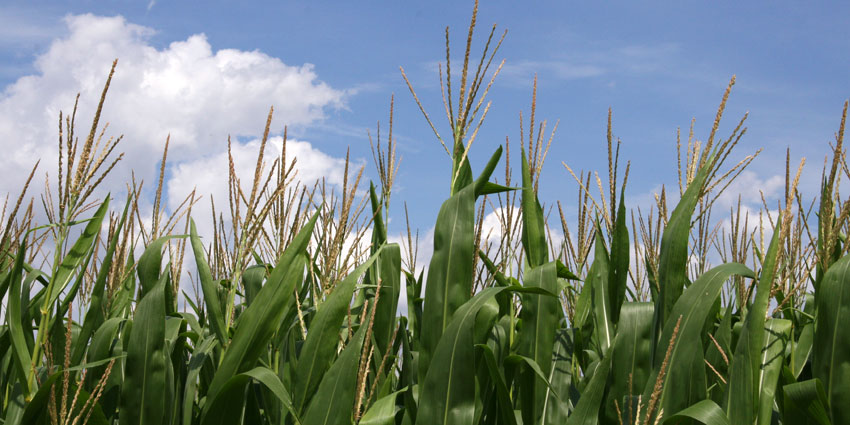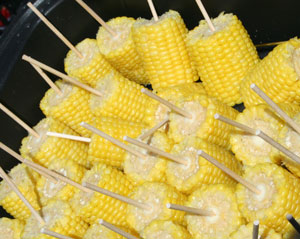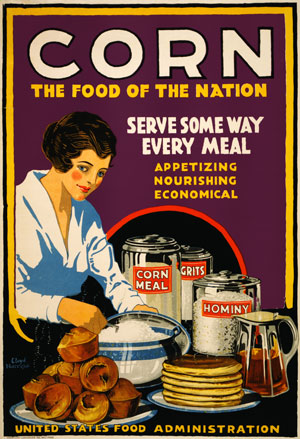
Lovelorn for Corn
Native to North and South America, corn has been part of people’s lives since humans began foraging for sustenance, although it did not quite look the same as it does today. The cultivation of corn began around 7,000 years ago. Seven millennia later (ital)Zea mays (maize or corn) has been crafted by gifted gardeners into the principal crop grown in the U.S. and an essential part of nourishment around the globe. Hearty and versatile, this remarkable plant offers far more than what meets the…ear.
 Starting with the basics, an ear of corn is easy to prepare, easy to eat, and tough to remove from between your teeth. Simple, filling, and fun to eat, it’s a staple of any picnic.
Starting with the basics, an ear of corn is easy to prepare, easy to eat, and tough to remove from between your teeth. Simple, filling, and fun to eat, it’s a staple of any picnic.
Ground corn varies in its use as to how finely it’s milled. Coarsely ground, it makes breakfast better as it takes the form of cornflakes or grits served with butter and pepper. Next step down in size is cornmeal, created into muffins like mom used to make. The finest milled is corn flour for tortillas and tamales…OLE!
Once an expendable byproduct of the process to separate the different parts of corn, steep liquor has proven to be invaluable. In the early 1940s, scientists discovered it to be a perfect medium for large scale production of penicillin. Prior to this discovery the antibiotic could only be produced in small batches. This breakthrough initiated an era of simple, effective treatments for often fatal infections.
Corn starch is extracted from what is called the (ital)endosperm, part of the seed responsible for the nourishment of future plantings. Gluten separated out of the endosperm leaves only a simple carbohydrate—another versatile component which is familiar to most cooks—used as a thickening agent for gravy and sauces. It’s also an ingredient for confectioner’s sugar, helping to create sweet treats. Corn syrup is also made from starch. Sweeter than sugar, its uses are endless, though these days it is losing favor due to its propensity to create love handles. Most unusual is its use as a main ingredient for biodegradable plastics.
Industrial uses of the crop offer a replacement of fossil fuels in the form of Ethanol. Most gas available these days is around 10% Ethanol. While it does make your car go, it requires about the same amount of energy to produce as what it has to offer. The amount of corn required to produce an abundance of the fuel would also make a substantial dent in the food supply.
Need an industrial glue? Yep…corn germ byproducts provide a key component for high-strength adhesives. As a supplement to resins it makes super glue more affordable.
Corn oil, yet another wonder of corn. Most well-known as a cooking ingredient, the oil is also used as an ingredient in soap, makeup, and medicine.
Corn cobs may be relegated to the trash barrel after a delicious meal, but they too have a litany of uses. Ground up for animal feed and bedding, it is also used to absorb oil and hazardous waste spills. At one time, some cultures deployed them as a toilet paper substitute (ouch). Its most famed use would certainly be in the form of the legendary corn cob pipe.
 Since corn was first cultivated it has been fermented…yes, liquor. As the United States was settled, creative colonists invented corn whiskey. Aside from its intoxicating qualities, growers and distillers also found barrels of whiskey were easier to transport than crops, and far more profitable. As the government realized its potential, taxes were levied during the Civil War. Bourbons such as Wild Turkey, Makers Mark, and Old Grand Dad (bourbon contain a minimum of 51 percent corn mash) were sold in stores, and taxed. In the spirit of the American way, moonshiners began producing “the shine” under the cover of the night to avoid the long arm of the law.
Since corn was first cultivated it has been fermented…yes, liquor. As the United States was settled, creative colonists invented corn whiskey. Aside from its intoxicating qualities, growers and distillers also found barrels of whiskey were easier to transport than crops, and far more profitable. As the government realized its potential, taxes were levied during the Civil War. Bourbons such as Wild Turkey, Makers Mark, and Old Grand Dad (bourbon contain a minimum of 51 percent corn mash) were sold in stores, and taxed. In the spirit of the American way, moonshiners began producing “the shine” under the cover of the night to avoid the long arm of the law.
Can you imagine going to the movies without popcorn? Like peanut butter and jelly or Lucy and Ethel, they go hand in hand. A salty buttery treat to munch on as the plot on the big screen unfolds, popcorn poppers were once a must have for students heading off to college. These days it is easily popped to perfection in minutes with the help of a microwave.
When it comes to shucking your corn, take note of the ease or difficulty of the task. According to New England folklore, if it’s tough to shuck, be prepared for a long cold winter. Corn silk was rolled and smoked, and had long been made into tea for home remedies, although it’s largely considered bogus these days. Husks were stuffed into mattresses for extra padding, and little girls made dolls from their corn husks long before toy stores dotted Main Street.
It is difficult to think of our lives without the multifaceted corn plant. What Thanksgiving dinner would be complete without yummy yellow kernels next to the mashed potatoes? Most everyone has some aspect of this crop touch their lives each day; a jug for milk, gasoline, penicillin, part of your morning makeup, watching a blockbuster film with a bucket of popcorn, or sipping an old fashioned after a hard day at work. This autumn, place your cornstalks prominently as they have truly earned their season in the spotlight.
—Susan Carroll-Dwyer




